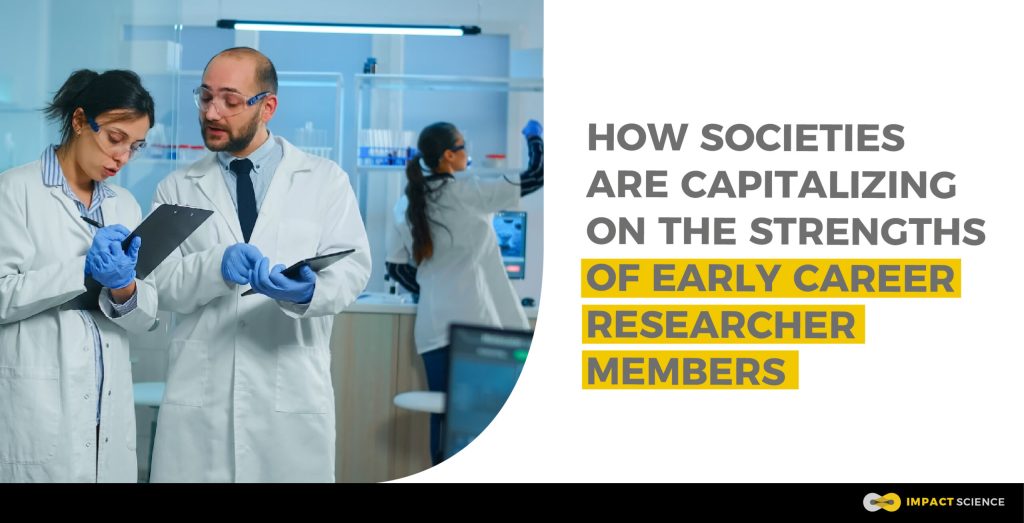Scholarly societies are a crucial part of the academic ecosystem; they are deeply invested in the interests of scholars in their academic community. The mission of such societies is to advance research and connect researchers through publications, meetings and conferences, and advocacy programs. As with any organization, the members, communication structure, and culture shape a scholarly society. A large part of scientific research is performed by early career researchers (ECRs), broadly including doctoral and postdoctoral researchers. ECRs constitute a sizeable membership of academic societies, as well as pools of potential authors, reviewers, and editors. However, leadership and decision-making positions in academic societies are largely held by senior researchers. Of late, ECR inclusion has become more than just a catch phrase, and societies are exploring new avenues for ECRs to hone their professional and leadership skills. By including these “future leaders” early on, societies can also blur out stringent boundaries between senior- and junior-level members, positively influencing research culture.
See also: How Academic Societies Are Reinventing Membership Experiences
Various Roles ECRs Can Play to Enrich Scholarly Societies
Many scholarly societies are recognizing how ECR members can add value. Below are some avenues where ECRs are contributing to supporting and strengthening the mission and goals of such societies.
1. Involvement in Editorial Workflows
The challenges ECRs face as authors and researchers during publication can provide novel perspectives on editorial strategy and journal operations. ECRs can help journal editorial boards in identifying innovative approaches and also share valuable insights into the expectations of a society journal’s audience.
a. Revitalizing editorial boards
Access Microbiology, an open access journal of the Microbiology Society, increases the engagement between early-career microbiologists and the Society’s publishing activities by teaming up ECRs with senior members of their editorial board. Many societies have started offering mentorship programs to train potential candidates for positions on editorial boards. Notable examples are editorial fellowships offered by JAMA Psychiatry and the American Gastroenterological Association, which arm ECRs with hands-on training in editorial processes and policies.
Further, there is no reason why ECRs may not be considered for posts such as Editor-in-Chief or for launching a new journal altogether! This has been done for a non-society journal, Drug Testing and Analysis.
b. Guest editors of special issues
A challenging and exciting option is asking ECRs to guest edit their own special issues. While they are mentored throughout, ECRs have the ownership and responsibility of curating such issues. Psychological Trauma by the American Psychological Association also encourages ECRs to submit to special issues and sections with topics relevant to other ECRs. An advantage of handing the reins of special issues to ECRs is that they can draw in authors the journal may not otherwise be able to.
2. Expanding Peer Reviewer Pools
Formal training for becoming a good reviewer benefits both the ECR (valuable experience and networking opportunities) and a society’s editorial board (wider reviewer pool, higher reviewing efficiency and turnaround). An increasing number of society journals offer formal peer review training to ECRs. The Genetics Society of America (GSA) offers online training to ECRs to become reviewers for manuscripts submitted to Genetics. The American Chemical Society also offers an interactive online training course that covers the basics of peer review, ethics, and writing a good peer review report. The Society for Neuroscience provides reviewer mentoring programs and materials for JNeurosci and eNeuro. ECR members work with a senior mentor on reviews of bioRxiv preprints for JNeurosci. After this “training,” these junior members are added to the reviewer pool.
See also: Five Components Every Publisher Should Include in Their Peer Reviewer Training Models
3. Involvement in Online and Offline Society Engagements
Networking and brainstorming events are great venues for capitalizing on the creative potential of ECRs. They can also help pinpoint obstacles faced by ECRs in hosting or organizing these events.
a. Offline events
The Biochemical Society, together with the British Pharmacological Society and the Physiological Society, runs Early Career Life Scientists’ Symposia, which are organized by ECRs for their peers. These symposia promote networking and professional development through social events, scientific talks, and poster sessions. Similarly, the Royal Society holds annual scientific meetings to bring together scientists from across the globe to present and discuss new research. Meeting proposals from ECRs are encouraged, who act as scientific organizers of the meeting.
b. Online events
Owing to the recent pandemic and collective recognition of the need to reduce carbon footprints, academic conferences and workshops have rapidly shifted online. Encouragingly, this shift has enabled the inclusion and increased participation of ECRs in such events. And so, leveraging their contributions to online events could be a good strategy for societies looking to generate creative ideas and higher engagement at society events and activities. Take, for example, the British Society for Neuroendocrinology’s summer webinar series run by and for ECRs. Flash talks and webinars by ECRs can showcase research being carried out by societies.
While young researchers gain experience in organizing events and public speaking on scientific topics, societies can draw from the ECRs’ acumen in running such events.
4. Strengthening a Society’s Social Media Presence
Researchers currently identifying as ECRs include millennials and Generation Z. Their exposure to and use of online platforms and social media are unparalleled among other demographics. This makes ECRs more amenable to network globally and seek and share opinions online. Societies can benefit from the ease and comfort with which ECRs use social media to increase their visibility.
Generation Z and millennial researchers tend to use Twitter to share their findings. There is also a rising trend of ECRs sharing educational “threads” related to their fields of expertise, academic writing, peer review, and more. This shows how ECRs are cued in to the needs of a scholarly audience. Thus, for societies to meaningfully engage with academia on Twitter, ECR members could be asked to “take over” a society’s handle and live-tweet updates on conference sessions or pathbreaking findings. An example of a society capitalizing on this opportunity is the American Heart Association, which offers blogging and live-tweeting opportunities specifically to ECRs.
See also: An Overview of TikTok for Societies
5. Generating Rich Multimedia Content
In the current digital era, societies can gain from tapping into various multimedia channels to diversify their portfolio and increase engagement. The verve of ECRs can be utilized in this domain quite fittingly. What’s more, they might even imbue content with creativity and fun!
The International Society for Microbial Ecology (ISME) Early Career Scientist Committee hosts video interviews with eminent scientists through their “ISME Conversations.” Such videos can increase engagement among society members and beyond. Meanwhile, the Early Career Scientist Multimedia Subcommittee of the GSA allows the communication of genetics research to a broad audience through curated podcasts (Genetics in Your World) and infographics. Through these media, ECRs draw attention to and discuss recent research appearing in GSA journals.
See also: How Societies and Research Institutions Can Use Comics for Outreach and Engagement
6. Exploring New Directions
a. Opportunities with preprints
Societies can find innovative ways to integrate preprints into their workflows and put ECRs on the job for this. For instance, the American Society for Cell Biology selects ECRs to join the editorial board of Molecular Biology of the Cell to highlight preprints posted on bioRxiv, alerting readers to the latest research and providing quick summaries of these preprints.
b. ECRs in advocacy efforts
Engaging ECRs in advocacy activities can help a society develop a larger pool of scientists with the skills and experience to work in advocacy as a part of their job profile. The Early Career Advocacy Fellowship by the American Physiological Society lets ECR members work on an advocacy-related project of their choice.
Final notes
The success of a scholarly society in achieving its goals and driving change hinges on dynamism in the face of the emerging thrust on open science, diversity and inclusion, innovative publishing workflows, and versatile communication platforms. Societies can learn from the experiences and challenges of ECRs to streamline their communication and content activities, ultimately improving scientific publishing and research culture. With their enthusiasm and fresh perspectives, ECRs can invigorate the running of a scientific society and make a difference to the future of the academic community.
Early career researchers have unique ways of accessing and sharing research. Learn more about them in this whitepaper.









